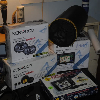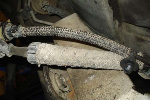Don, the nitrous stuff is pretty easy. I suggest running a wet type of system versus a dry. I have explained this before in multiple threads, so I won't elaborate in here besides saying that it is more tunable and safe. So, with a wet system only supplying about 100shot, just going with a wet nozzle system is fine. Both the fuel and nitrous plumb into that one nozzle. Location of this nozzle should be between the MAFS and the TB (Post-MAFS & pre-TB); usually a few inches away from the TB and spraying directly into it. DO NOT PLACE IT BEFORE THE MAFS (between air filter and MAFS)! If you want, you can do a few IATS things with spark retardation as well, but again, I won't bother talking about that right now. As for places to get the fuel from? I cannot recall if the stock 5.0 Explorer rails have a schrader test valve on them or not, but if they do then that would be a good location to pull fuel from. If not, then just splice into the fuel line with the proper Tee junction that will withstand ~44psi of fuel pressure and call it a day. No big deal, really.
Rocket, while your here, what are your thoughts on the factory 12" torque converter clutch holding up to 450hp? This is relevant to this thread. I do understand that one would want a slightly higher stall, but wonder about larger clutches, multi clutches, etc.
Going with a higher stall really depends on many things, the main factors being user preference, mod combo, and if you want to be able to lock the TC up at WOT. Those all make a big difference, really. While a "3,000rpm" TC may work well for a person with a given combo, it may not work well for another running something different. Also, some people just prefer different stall speeds which especially becomes noticed in street vehicles. For instance, I am running a Circle D 258mm (3,000rpm) triple disk lockup TC in my twin turbocharged G8 because I wanted the capability to lock the clutches at WOT under full power. For some folks with similar combos to me 3000 was too high for their preference, for others it was too low. Some wanted the WOT lockup capability for high power combos while others did not want to pay the $400 premium. Also, for those running a roots supercharger, they wouldn't need to go as high with the stall, etc. Also, stall ratings are subjective. If a given TC is rated at 2500rpm stall for a combo making 450rwhp, and I throw it in my G8 which makes 640rwhp then it will stall at a much higher rpm than 2500. My point is to take the "stall speed rating" with a relative grain of salt.
There is no one size fits all unfortunately. That's why it is best to either have a combo 100% locked into a plan that won't change before specing and buying a TC, or just wait until the build is almost finished if you aren't that decisive with the initial direction the combo is going to take. Either way, expect to pay anywhere from $800-$1200 for a quality TC; with $800 being single disk lockup and $1200 being where the multi-disk units come in at.
Cliffnotes Generally speaking:
-Lockup vs non-lockup: Do you want the ability to lock or not lock the TC at speed? What this means for cruising is locking the TC in a 1:1 ratio so that there is no parasitic drive losses due to a speed differential between what the engine is spinning at and what the trans input shaft is doing. Lockup usually means better fuel economy. Lockup for racing means determining when you are done needing that torque multiplication that the TC provides in the earlier RPMs, and just want the HP on the top end. Sometimes locking up at WOT can provide a better ET, but it also introduces considerably more stress to drivetrain parts; which means that if you want to lock at WOT and are making some serious power then you had better make sure that your transmission can hold it!
-Clutch sizes: The larger the contact surface area of the clutches inside the transmission the better. Clamping force of the shift solenoids comes into play here too, but generally speaking the bigger and more clutches that you can fit, the less slippage you will encounter. This is also the same for the lockup clutches in a lockup TC as well.
-Multi-disk vs single disk lockup: You can kind of derive an explanation of this based upon what I talked about in clutch sizes. Multidisk will allow the holding of more power than the single disk will when it comes to lockup at WOT.










